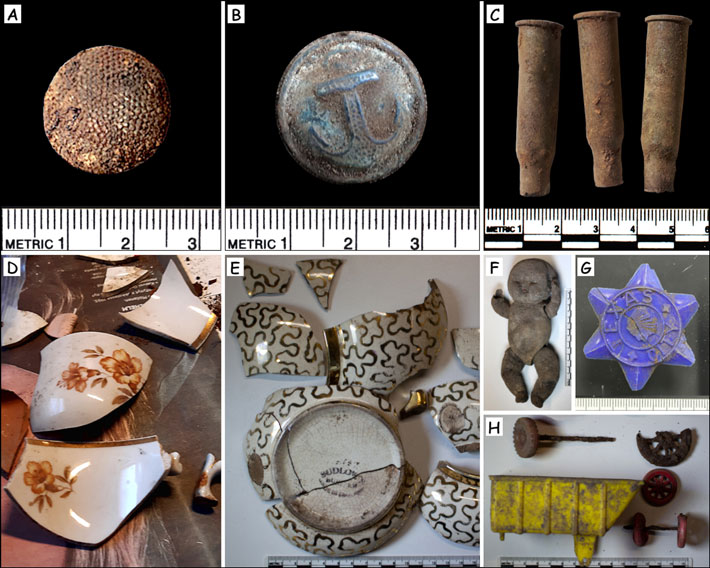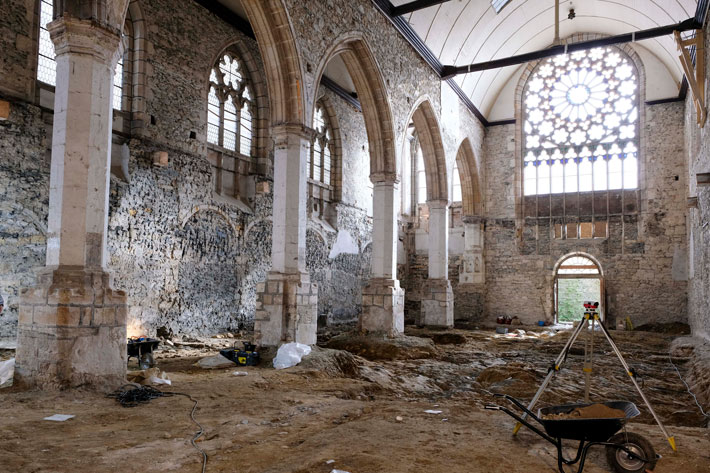Demolished 20th-Century Neighborhood Investigated in Finland
Thursday, March 7, 2024

(Seitsonen et al. 2024/© Antiquity Publications Ltd.)
OULU, FINLAND—According to a statement released by Antiquity, an excavation conducted at Vaakunakylä, a neighborhood in west-central Finland established by German troops during World War II, unearthed items left by Finns who moved into the site in the late 1940s. The working-class settlement, which had been labeled as a “bad” neighborhood, was demolished against the wishes of its residents in the late 1980s. Oula Seitsonen of the University of Oulu and his colleagues determined that the original military barracks had been refurbished as family housing. One of the buildings was even repurposed as a sauna, he said. Pieces of several porcelain sets, suggesting that the post-war residents had a higher standard of living than previously thought, were found in rubbish pits. Toys, children’s medication, and pacifiers also point to a good quality of life, Seitsonen explained. Finally, the researchers conducted interviews with former residents of Vaakunakylä, who remembered the community in a generally positive light. “Both the finds and the collected oral histories give a different and more nuanced picture of the Vaakunakylä community than the popular image of the area as a restless and criminal slum-like shantytown,” Seitsonen said. “We hope that this can have a healing aspect when the pent-up feelings are brought to the surface and discussed in public,” he concluded.
Thursday, March 7, 2024

(© Emmanuelle Collado, Inrap)
MORLAIX, FRANCE—The Miami Herald reports that an excavation at the site of a 700-year-old Roman Catholic convent in northwestern France, conducted by researchers from France’s National Institute of Preventive Archaeological Research, has uncovered remains of the church, more than 200 burials, jewelry, and religious devotional objects. The convent was established by the Dominican Order, known as the Jacobin Order in France, in 1238. The church dates to 1250, and was restored and expanded after a fire in 1344. Most of the burials in the church, which contained the remains of men, women, and children, were in single tombs, but joint tombs in masonry vaults were also found. One of these vaults held the remains of 17 people. Artifacts recovered from the burials include traces of wooden coffins; copper pins that were used to hold shrouds in place; rings; bracelets; rosaries made of wood, bone, stone, and glass; crucifixes made of wood, copper, and terracotta; a silk scapular with a silver wire; and a unique skull-shaped object made of bone.
Thursday, March 7, 2024
NUREMBERG, GERMANY—According to a CNN report, eight plague pits estimated to hold the remains of more than 1,500 people were discovered in southern Germany during an investigation conducted ahead of a construction project. Plague outbreaks are known to have occurred in Nuremberg roughly every 10 years, beginning in the fourteenth century. Radiocarbon dating of one of the pits indicates that it was in use between the late fifteenth century and early seventeenth century, while early seventeenth century pottery and coins were also recovered, said Melanie Langbein of Nuremberg’s Department for Heritage Conservation. Meanwhile, historic records show that a plague outbreak killed more than 15,000 people in Nuremberg in 1632 and 1633, resulting in the burial of more than 2,000 people in the area where the excavation is being conducted. Dire conditions brought about by the Thirty Years' War, fought from 1618 to 1648, likely made this particular plague outbreak more deadly, and required the use of plague pits to accommodate the dead, Langbein added. “Those people were not interred in a regular cemetery although we have designated plague cemeteries in Nuremberg,” she explained.
To read about a mass grave of soldiers who died during the Thirty Years' War Battle of Lützen in 1632, go to "Last Stand of the Blue Brigade."
No comments:
Post a Comment